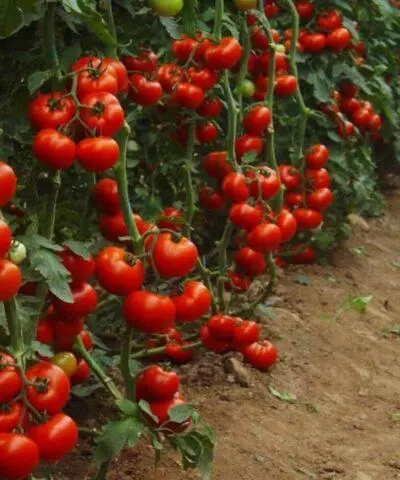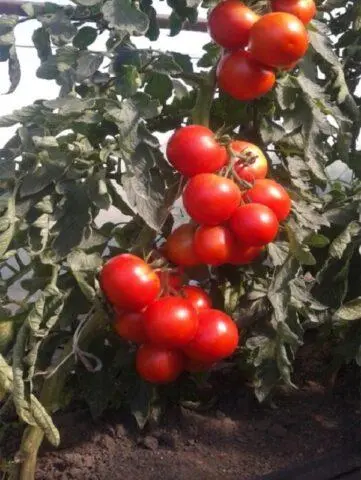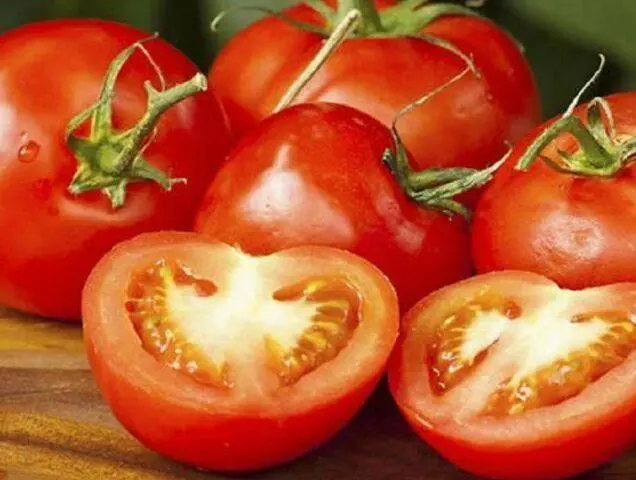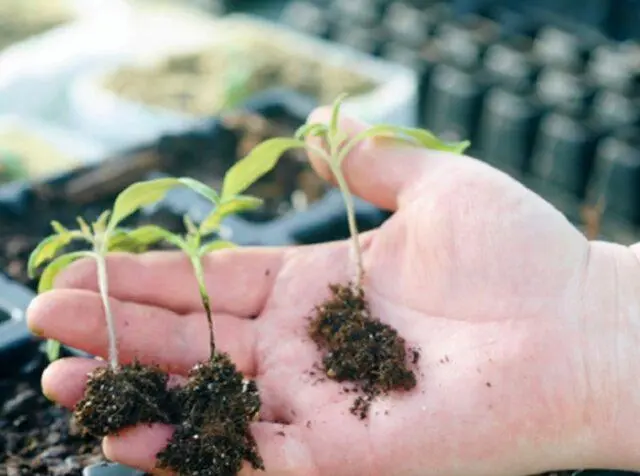Contents
Tomato Lezhebok is a culture of a determinant type. The hybrid belongs to varieties of early ripening. Grown in all regions in a closed or open way (depending on the climate). The variety is productive, with stable immunity. The fruits are transportable, retain their presentation and taste for a long time. Tomatoes of the variety are all of the same mass, ripening is friendly.
History of occurrence
Tomato Lezhebok was created on the basis of Gavrish LLC in 1998. The target direction of hybridization is to obtain an early ripening tomato with a long shelf life. Experimental cultivation confirmed all the characteristics declared by the originator, and in 2002 the Lezhebok hybrid was added to the list of the State Register.
Approved for cultivation in the open ground of the Southern regions, in the Central and Middle lane – in film tunnels and cold closed structures, in the North-Eastern regions – in heated greenhouses.
Description of the variety of tomato Lezhebok
Bush open determinant, non-standard type, generative type of growth. The priority in the growing season is the ripening of the fruit, and not the growth of the crown. The tomato is formed by two stems, the height of which does not exceed 130 cm.
Description of the variety Lezhebok:
- Bearing shoots are not thick, rigid, due to their length they require fixation to the trellis. The surface is slightly ribbed, light green, pubescent.
- Lateral shoots are few and grow slowly.
- The leaves are elongated, with carved edges, dark green, tripartite.
- The flowers are small, yellow, each gives a viable ovary. Tomato Lezhebok is self-pollinated, the yield of marketable products is 98%.
- Fruit clusters are simple. Density – 4-5 tomatoes. The lower brush is formed from the sixth leaf sinus, the subsequent ones from every second. There are 4-5 pieces on the stem.
- Tomatoes are flat-round, weighing 120-140 g.

- The surface is smooth, the peel is red, with a glossy sheen. The pulp is dense, with two seed chambers. Unripe tomatoes have white, hard segments.
The taste of tomatoes is sweet and sour, the aroma is not pronounced.

Fruit clusters are heavy, a tie to the stem is recommended
Characteristics of tomato Lezhebok
The hybrid is early, from the moment of germination to the removal of the first fruits, 110 days pass. The Lezhebok variety is harvested in July. Fruiting is not stretched, the tomatoes of the lower and last brushes ripen at the same time. If tomatoes remain in the stage of technical ripeness, after unloading the bush, they need 7-12 days until they fully ripen.
The yield of tomato Lezhebok
The formation of a bush with three or more stems to increase the yield is not justified, since there will be more tomatoes, but their mass will be less. The output will be the same as that of a tomato Lazhebok with two shoots, but with a normal fruit weight. From one plant collect 5-5,5 kg. 1 m2 it is not recommended to place more than three tomatoes. Ideally, two seedlings. The fruiting rate per 1 m² ranges from 12-15 kg.
Disease and pest resistance
The couch potato, like all hybrid forms of culture, is highly resistant to damage by pathogenic microorganisms. Tomato is not afraid of the following infections:
- fusarium wilt;
- late blight;
- Phomosis;
- leaf mold;
- brown spotting;
- top and root rot.
If the watering regime is not observed during the cultivation of seedlings, the tomato Lyzhebok can become infected with a black leg.
The Colorado potato beetle, aphids, slugs, and whiteflies do not harm the culture.
In heated greenhouses with high air humidity and dense planting, a spider mite parasitizes on the tomato Lazhebok.
Application area
You can use the harvested crop for all types of processing, except for obtaining juice. The hybrid in this regard is not productive. Pasta, mashed potatoes are made from tomato cod, but more often they are used for whole-fruit canning or cold pickling. The main purpose of the fruit is to eat fresh in salads or in regular cuts. Also, tomatoes are quite suitable for culinary recipes.
Advantages and disadvantages
Tomato Lezhebok is grown in household plots and in the fields of agro-complexes. In the latter case, the purpose is commercial. The hybrid without loss of a trade dress transfers transportation on rather long distances.

Tomatoes of the Lezhebok variety picked in July at a temperature of +40 C do not lose their nutritional value until November
Pros:
- early friendly maturation;
- high yield;
- long periods of storage;
- possibility of cultivation in all regions;
- suitable for open ground and greenhouses;
- standard agricultural practices;
- immunity to infections and pests;
- versatility in use;
- does not crack and does not bake in the sun.
Cons:
- unexpressed aroma;
- during long storage, voids form in the pulp;
- the possibility of seed germination in the whole tomato;
- does not provide complete material for reproduction.
Peculiarities of growing
Seeds are purchased from a retail chain. The original material is sold only by Gavrish. Pre-sorting and disinfection is not needed, the tomato Lezhebok is processed before packaging. An early variety is grown from seedlings. To obtain planting material, the laying of tomato seeds is carried out at the end of March:
- Fill containers with a mixture of compost and peat, you can purchase a ready-made substrate.
- Watered with a hot solution of manganese, left for a day.
- Longitudinal grooves are made on the surface, the tomato is distributed at 1 cm intervals. Cover with soil and watered with any growth stimulant.
- The containers are covered, the temperature is maintained at + 22-25 0C.
- After the appearance of sprouts, the covering structure is removed, the daylight hours are increased to 16 hours.
- As the top layer of the substrate dries, water it with an aerosol method.
- After the formation of three leaves, the seedlings dive into separate containers.

Planted tomato Lyzhebok at the age of 60 days
Placed on an open bed approximately in May. In the greenhouse you can earlier:
- They dig up a place for tomatoes, remove the roots and remains of vegetation, and add compost.
- Planted tomato Lyzhebok with an interval of 50 – 60 cm in furrows or trenches.
- The depth of the seat is along the lower leaves, the width is to completely distribute the root along the bottom.
- Seedlings are covered with soil and watered abundantly with Energen.
When the tomato rises to 20 cm, spud and cover with a layer of humus mulch.
Agrotechnics of the hybrid Lezhebok:
- Watering in greenhouses twice in 10 days (20 liters of water up to the root). In an open area, they are guided by precipitation so that the soil does not dry out, but there is no stagnation of moisture.
- The trunk circle is loosened to prevent compaction. Remove weeds.
- Feed the tomato with nitrogen – before flowering, phosphorus – during the formation of ovaries. After 15 days, they give potassium, after two weeks – superphosphate. The introduction of liquid organics is combined with irrigation.
The stems are tied up, excess leaves are removed, stepchildren.
Pest and disease control methods
For preventive purposes, at the beginning of the growing season, the tomato is treated at a permanent place with preparations containing copper.
These measures are enough so that the tomatoes do not get sick.
When growing seedlings, do not allow low temperatures and stagnation of water in the container. If the conditions are not met, the seedlings are affected by the black leg. It will not work to save a diseased plant; such material is rejected.

The lesion is determined by a dark area in the area of the root neck, rotting quickly spreads to the stem and causes the death of the plant

A spider mite parasitic on a tomato couch potato is destroyed at the first sign of its appearance with the drug “Iskra Bio”
A sucking microscopic insect wraps its web around the main location
Conclusion
Tomato Lyzhebok – a hybrid with a long shelf life. The fruits ripen together in July, the yield is high. Medium weight tomatoes, suitable for fresh consumption and processing. A medium-sized variety is grown in seedlings in a greenhouse and in an open area.









